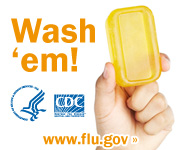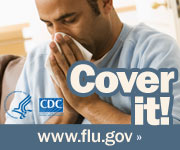Resources and ideas for teachers of learners with severe, profound, intensive, significant, complex or multiple special needs.
Showing posts with label hand washing. Show all posts
Showing posts with label hand washing. Show all posts
Thursday, October 15, 2009
Sunday, October 11, 2009
Preventing the Flu - Seasonal or H1N1 - in Our High risk Students
I have a sore arm, not from softball or even typing IEPs but from my seasonal flu shot. My sore arm has caused me to start thinking about the flu, in particular the H1N1 Flu that so many people are talking about right now.
It has been broadly noted that of the 36 child deaths from H1N1 67% (this is about 9% higher than the yearly seasonal flu) had a high risk medical condition and 92% of those with a high risk medical condition were children with neurodevelopmental conditions.Of the 02% who had a neurodevelopmental condition 59% had multiple neurodevelopmental disabilities and 41% had chronic pulmonary problems. Many of these children also had a hospital accquired infection like MRSA when they died. (From The Surveillance of Pediatric Deaths Associated with the 2009 H1N1 Epidemic by the CDC.)
What this means is that our students with severe and multiple disabilities are at very high risk should they become infected with the H1N1 flu, or really any influenza infection. Already some strains of the virus are resistant to anti-viral medication, so prevention is our number on weapon. We as teachers, working with our supervisors and program or classroom nurses are at the forefront of ensuring that our students do not become infected with any strain of flu virus, including H1N1 at school.
Prevention Guidelines (from the CDC)
H1N1 Symptoms (from the CDC)
Other Flu Links







It has been broadly noted that of the 36 child deaths from H1N1 67% (this is about 9% higher than the yearly seasonal flu) had a high risk medical condition and 92% of those with a high risk medical condition were children with neurodevelopmental conditions.Of the 02% who had a neurodevelopmental condition 59% had multiple neurodevelopmental disabilities and 41% had chronic pulmonary problems. Many of these children also had a hospital accquired infection like MRSA when they died. (From The Surveillance of Pediatric Deaths Associated with the 2009 H1N1 Epidemic by the CDC.)
What this means is that our students with severe and multiple disabilities are at very high risk should they become infected with the H1N1 flu, or really any influenza infection. Already some strains of the virus are resistant to anti-viral medication, so prevention is our number on weapon. We as teachers, working with our supervisors and program or classroom nurses are at the forefront of ensuring that our students do not become infected with any strain of flu virus, including H1N1 at school.
Prevention Guidelines (from the CDC)
- If you are ill, stay home until fever is gone without medication for 24 hours
- If students are sick they should be required to stay home until temperature is normal for 24 hours without medication
- Frequently wash your hands with soap and water and assist students with hand washing following hand washing guidelines (warm water, use soap, rub for twenty seconds, etc.)
- If soap and water is not available use an alcohol based sanitizer frequently (rub until dry)
- Wash/sanitize all the areas of your hands palms, backs, between fingers, fingertips, thumb & wrist, nails
- Avoid touching eyes, nose and mouth and wash hands after touching face
- When coughing or sneezing over mouth/nose with a tissue and dispose of immediately in waste basket, then wash hands
- H1N1 can survive 2-8 hours on surfaces, decontamination can be done using heat 167-212°F, chlorine (bleach), hydrogen peroxide, detergents (soap), iodophors (iodine-based antiseptics), and alcohol (such as alcohol based cleaners/sanitizers)
- Surfaces like phones, keyboards, and doorknobs (not to mention switches) should be cleaned with alcohol wipes or anti-flu cleaning wipe often
- Clothes and linens can be washed with other items using regular laundry detergent and tumbled dry on high heat, care should be taken not to "hug" the dirty laundry to you before washing and wash hands after handling dirty laundry
- Eating utensils should be washed in a dish washer or by hand using soap and water
- For the record you cannot catch H1N1 from eating pork or pork products
H1N1 Symptoms (from the CDC)
- fever
- cough
- sore throat
- runny or stuffy nose
- body aches
- headache
- chills
- fatigue
- some people may have vomiting and diarrhea
Other Flu Links
- CDC on H1N1
- weekly flu tracking from the CDC
- swine flu plush toy
- talking to kids about H1N1
- how to wash and sanitize your hands poster
- Handwashing Sign Kit for Schools
- Handwashing Curriculum
- Soapacabana
- H1N1 ABC Song







Sunday, September 23, 2007
Cold and Flu Season
 School is back and session and thus student and teacher exposure to colds and flus is back as well and the special needs room is no exception. During my camping trip this weekend I was hit with the nasty head cold that several of my students and a few of the adults in my room had during last week. That means it is time for me to teach my annual germ lesson.
School is back and session and thus student and teacher exposure to colds and flus is back as well and the special needs room is no exception. During my camping trip this weekend I was hit with the nasty head cold that several of my students and a few of the adults in my room had during last week. That means it is time for me to teach my annual germ lesson.Lesson objective: to teach students how germs spread and techniques for minimizing the spread of germs
Materials: green glitters, Kleenex, sink (or a basin and pitcher of water) soap ( preferably pump soap), sequence strip of hand washing steps, fantastic or another cleaner, paper towels, sequence strip of washing surfaces with a spray cleaner, large picture symbol and text based rules depicting germ protection rules (cover coughs and sneezes with a tissue and/or crook of arm, wash hands before and after sneeze, cough, nose blowing, touching face, eating and using rest room, wash tables and desks every day and more often if you are sick, stay home if you are sick, wear a germ mask if you have a cold and come to school)
Procedure:
1. elicit a working definition of "germs", usually something along the lines of tiny bugs that cannot be seen without a microscope that can make people and animal sick
2. explain to the students that during this lesson the green glitter will be germs
3. Without the students seeing loisten your hand and fill the palm of with green glitter and then pretend to sneeze tossing the glitter out in front of your mouth as you do. Most students will have a big reaction to the "germs" landing on them.
4. Elicit an explanation of what happened when you sneezed. Ask the students what you could have done differently, try to get to the answer, "covered your mouth with a tissue".
5. As you are having this discussion pat the students on the shoulders, give high fives and shake hands with students and adults -- get green glitter on as many people and surfaces as possible.
6. Secretly get more glitter and "sneeze" again, cover your mouth with your tissue and your hands. Put the green glitter covered tissue (the green glitter you just rubbed all over the tissue) down on the table or desk in front of the student the most likely to tell you to get it off and throw it away. When asked to do this elicit a reason why and then throw it away.
7. Keep sneezing or coughing and shaking hands and giving high fives talking in complex terms about germs and viruses and how viruses dock into mucous membranes. It is not important that the students retain any of what you are saying at this point you want a visceral reaction to how the green glitter germs are getting on everything and everybody. For good measure touch your nose and around your mouth to be sure there is green glitter there. Keep going until it appears everyone gets the idea and is at least noticing how pervasive the green glitter has become.
8. Stop talking and ask the students who are having the most visible reactions what is wrong. Establish the fact that the green glitter germs have spread all over the room and are now on the clothing, hands and faces of many people. Ask to students to write a plan to eliminate the green glitter germs.
9. Write out the plan on the board or a flip chart. It should include everyone washing their hands and faces with soap and water, all of the tables and chairs being sprayed and washed with Fantastic or 409 or another cleaner.
10. Review the steps for hand washing with the sequence strip, post the strip and have the students line up and wash faces and hands, starting with you as a model. Have them stay standing in a line when done as to not get more green glitter on themselves by sitting back at glitter covered tables/desks.
11. Review the steps for cleaning tables desks with the sequence strip and then assist the students in cleaning the tables and desks.
12. Once the clean up is done have the students brainstorm a list of rules for stopping the spread of germs and then have them all sign it. Consider making a strip of symbols of each rule for each desk, tray or table.
13. Finish by drawing off a section of the board and asking students to report places they see green glitter germs over the next few days (you will be shocked at how far the glitter gets).
Evaluation:
1. keep data on how frequently students engage in germ stopping behaviors, challenge them to get better at it
2. give a germ stopper quiz you design to be appropriate to your ability students
Links:
I strongly recommend the It's A SNAP link. It is a curriculum to help a team set up an absenteeism prevention campaign based on hand washing. But even if you aren't interested in setting up a campaign the tool kit has great ideas, curriculum, connections to standards and more.
More Social Skills Stories includes "Scott Snot" and "Sneeze Louise"
The Common Cold Prevention and Treatment
Kids Talk: An Ounce of Prevention
Subscribe to:
Posts (Atom)




